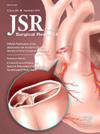不同社会人口群体的小儿尤文肉瘤表现、治疗和结果
IF 1.8
3区 医学
Q2 SURGERY
引用次数: 0
摘要
导言在这项研究中,我们评估了患有尤文肉瘤的儿童、青少年和年轻成人的社会人口统计学与疾病表现、治疗和生存之间的关联。方法从监测、流行病学和最终结果数据库下载病例级数据。病例包括2004年至2020年期间被诊断为尤文肉瘤的0-24岁患者。与非西班牙裔白人(NHW)患者相比,西班牙裔患者更有可能出现肿瘤≥8厘米(几率比(OR)=1.71,95%置信区间(CI)=1.24-2.36)和转移(OR=1.65,95%置信区间(CI)=1.23-2.20)。黑人患者接受化疗的可能性较低(OR = 0.25,95% CI = 0.07-0.97)。非华裔患者的5年疾病特异性生存率为73%,黑人患者为65%,亚裔患者为67%,西班牙裔患者为66%。考虑到混杂因素,西班牙裔和亚裔患者因癌症死亡的概率高于非白血病患者(HR = 1.41,95% CI = 1.10-1.81;HR = 1.64,95% CI = 1.09-2.48)。结论不同年龄组和种族/民族的尤文肉瘤发病、治疗和生存率存在显著差异。今后的工作重点应放在扩大医疗服务不足群体的就医机会上。进一步的定性研究有助于确定阻碍患者获得治疗的确切因素,或研究不同人口群体中导致尤文肉瘤严重程度的遗传因素有何不同。本文章由计算机程序翻译,如有差异,请以英文原文为准。
Pediatric Ewing Sarcoma Presentation, Treatment, and Outcomes Across Sociodemographic Groups
Introduction
In this study, we evaluate the association between sociodemographics and disease presentation, treatment, and survival for children, adolescents, and young adults with Ewing sarcoma.
Methods
Case-level data were downloaded from The Surveillance, Epidemiology, and End Results database. Cases included patients ages 0-24 who were diagnosed with Ewing sarcoma between 2004 and 2020.
Results
One thousand two hundred forty four patients were included in the analysis. When compared to non-Hispanic White (NHW) patients, Hispanic patients were more likely to present with tumors ≥8 cm (odds ratio (OR) = 1.71, 95% confidence interval (CI) = 1.24-2.36) and metastases (OR = 1.65, 95% CI = 1.23-2.20). Black patients were less likely to receive chemotherapy (OR = 0.25, 95% CI = 0.07-0.97). The 5-year disease-specific survival rate was 73% for NHW patients, 65% for Black patients, 67% for Asian patients and 66% for Hispanic patients. When accounting for confounding factors, Hispanic and Asian patients had higher probabilities of death due to cancer compared to NHW patients (HR = 1.41, 95% CI = 1.10-1.81; HR = 1.64, 95% CI = 1.09-2.48, respectively). Young adults and adolescents were significantly more likely to present with metastases, experience ≥1 month between diagnosis and treatment, and had lower survival.
Conclusions
Significant differences in Ewing sarcoma presentation, treatment, and survival were observed across age groups and race/ethnicity. Future work should focus on expanding access to care in underserved groups. Further qualitative studies could assist in determining the exact factors that prevent patients from accessing care or examine how genetic factors that contribute to Ewing sarcoma severity differ across demographic groups.
求助全文
通过发布文献求助,成功后即可免费获取论文全文。
去求助
来源期刊
CiteScore
3.90
自引率
4.50%
发文量
627
审稿时长
138 days
期刊介绍:
The Journal of Surgical Research: Clinical and Laboratory Investigation publishes original articles concerned with clinical and laboratory investigations relevant to surgical practice and teaching. The journal emphasizes reports of clinical investigations or fundamental research bearing directly on surgical management that will be of general interest to a broad range of surgeons and surgical researchers. The articles presented need not have been the products of surgeons or of surgical laboratories.
The Journal of Surgical Research also features review articles and special articles relating to educational, research, or social issues of interest to the academic surgical community.

 求助内容:
求助内容: 应助结果提醒方式:
应助结果提醒方式:


